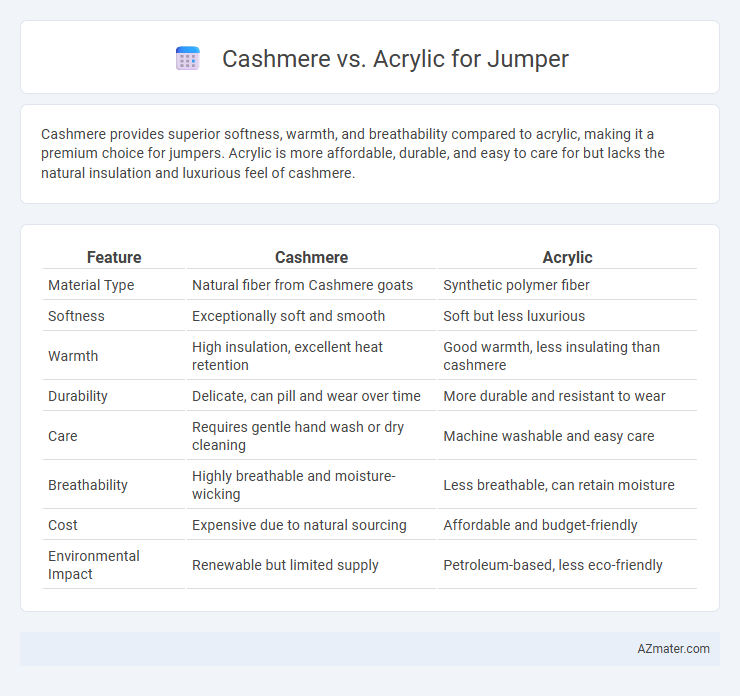Cashmere provides superior softness, warmth, and breathability compared to acrylic, making it a premium choice for jumpers. Acrylic is more affordable, durable, and easy to care for but lacks the natural insulation and luxurious feel of cashmere.
Table of Comparison
| Feature | Cashmere | Acrylic |
|---|---|---|
| Material Type | Natural fiber from Cashmere goats | Synthetic polymer fiber |
| Softness | Exceptionally soft and smooth | Soft but less luxurious |
| Warmth | High insulation, excellent heat retention | Good warmth, less insulating than cashmere |
| Durability | Delicate, can pill and wear over time | More durable and resistant to wear |
| Care | Requires gentle hand wash or dry cleaning | Machine washable and easy care |
| Breathability | Highly breathable and moisture-wicking | Less breathable, can retain moisture |
| Cost | Expensive due to natural sourcing | Affordable and budget-friendly |
| Environmental Impact | Renewable but limited supply | Petroleum-based, less eco-friendly |
Introduction: Cashmere vs Acrylic Jumpers
Cashmere jumpers offer unparalleled softness and natural insulation due to their fine goat hair fibers, making them a luxurious choice for warmth and comfort. Acrylic jumpers, made from synthetic fibers, provide durability and affordability while mimicking the look and feel of wool but lack the breathability and softness of cashmere. Choosing between cashmere and acrylic jumpers depends on priorities such as budget, maintenance, and desired texture.
Material Origins and Production Process
Cashmere originates from the undercoat of Cashmere goats primarily found in Mongolia, China, and Nepal, known for its natural warmth and softness due to fine, downy fibers harvested by combing during the molting season. Acrylic is a synthetic fiber produced from polymer compounds derived from fossil fuels through a chemical process called polymerization, designed to mimic the softness and warmth of natural fibers but with increased durability and resistance to moth damage. Cashmere requires meticulous hand processing and dehairing to separate fine fibers from coarse guard hairs, while acrylic yarns are manufactured industrially through extrusion and spinning, offering a more consistent texture and easier care.
Texture and Softness Comparison
Cashmere jumpers offer unparalleled softness and a luxurious texture due to their fine, natural fibers harvested from cashmere goats, providing exceptional warmth while remaining lightweight. Acrylic jumpers mimic the softness of natural fibers but often feel less breathable and can have a slightly synthetic texture compared to genuine cashmere. The superior texture and softness of cashmere make it a preferred choice for those seeking comfort and elegance in their knitwear.
Warmth and Insulation Properties
Cashmere jumpers provide superior warmth and insulation due to their fine, natural fibers that trap heat effectively while allowing breathability, making them ideal for cold weather. Acrylic jumpers offer decent insulation but generally lack the same heat-retention capabilities and softness found in cashmere, often resulting in less comfort in extreme cold. The natural fiber structure of cashmere outperforms synthetic acrylic, delivering better moisture-wicking and temperature regulation properties.
Durability and Longevity
Cashmere jumpers offer exceptional durability due to fine, natural fibers that become softer with wear while maintaining strength and resistance to pilling. Acrylic jumpers are less durable, often prone to pilling and fiber damage over time, leading to a shorter lifespan compared to cashmere. Investing in cashmere ensures long-lasting softness and resilience, making it a superior choice for longevity in knitwear.
Maintenance and Care Requirements
Cashmere jumpers require gentle hand washing with cold water and mild detergent or dry cleaning to maintain softness and prevent damage, while acrylic jumpers are machine washable and more resistant to shrinking and stretching, making them easier to care for. Cashmere fibers demand delicate handling to avoid pilling and loss of insulation properties, whereas acrylic's synthetic composition allows for frequent washing without significant wear. Proper storage of cashmere involves folding and placing in breathable garment bags to preserve fiber quality, contrasting with acrylic's less stringent storage needs.
Allergies and Skin Sensitivity
Cashmere is a natural fiber known for its softness and hypoallergenic properties, making it ideal for individuals with sensitive skin or allergies. Acrylic, a synthetic fiber, can sometimes cause irritation or allergic reactions due to its chemical composition and lack of breathability. Choosing cashmere jumpers reduces the risk of skin sensitivity and provides superior comfort compared to acrylic alternatives.
Price and Affordability
Cashmere jumpers are known for their luxurious softness and warmth, but they come with a higher price tag, often ranging from $150 to $500 or more per piece, making them a premium choice for budget-conscious shoppers. Acrylic jumpers are significantly more affordable, typically priced between $20 and $60, offering a cost-effective alternative that mimics the feel of wool without the expense. The affordability of acrylic makes it a popular option for casual wear and those seeking budget-friendly knitwear without sacrificing style.
Environmental Impact and Sustainability
Cashmere jumpers, sourced from the soft undercoat of cashmere goats, have a significant environmental footprint due to overgrazing and water-intensive production, contributing to land degradation and biodiversity loss. Acrylic jumpers, made from petroleum-based synthetic fibers, rely heavily on non-renewable resources and generate microplastic pollution during washing, impacting marine ecosystems. Sustainable alternatives involve choosing responsibly sourced cashmere with certified standards or recycled acrylic fibers that reduce resource consumption and environmental damage.
Which Jumper Material Should You Choose?
Cashmere offers superior warmth, softness, and breathability, making it ideal for luxurious, high-quality jumpers that provide comfort and durability. Acrylic jumpers are more affordable, lightweight, and easy to care for, but they lack the natural insulation and moisture-wicking properties of cashmere. Choose cashmere for premium warmth and softness, while acrylic suits budget-friendly, low-maintenance options.

Infographic: Cashmere vs Acrylic for Jumper
 azmater.com
azmater.com